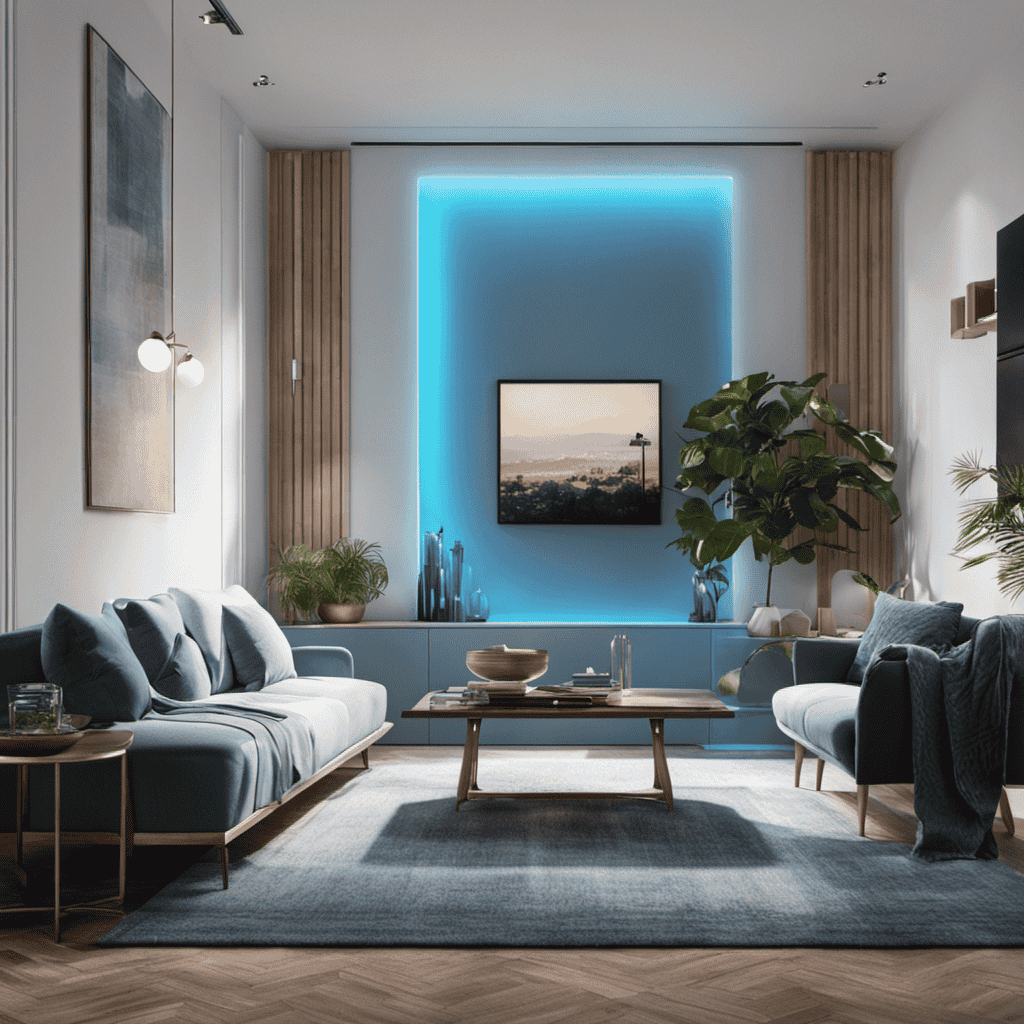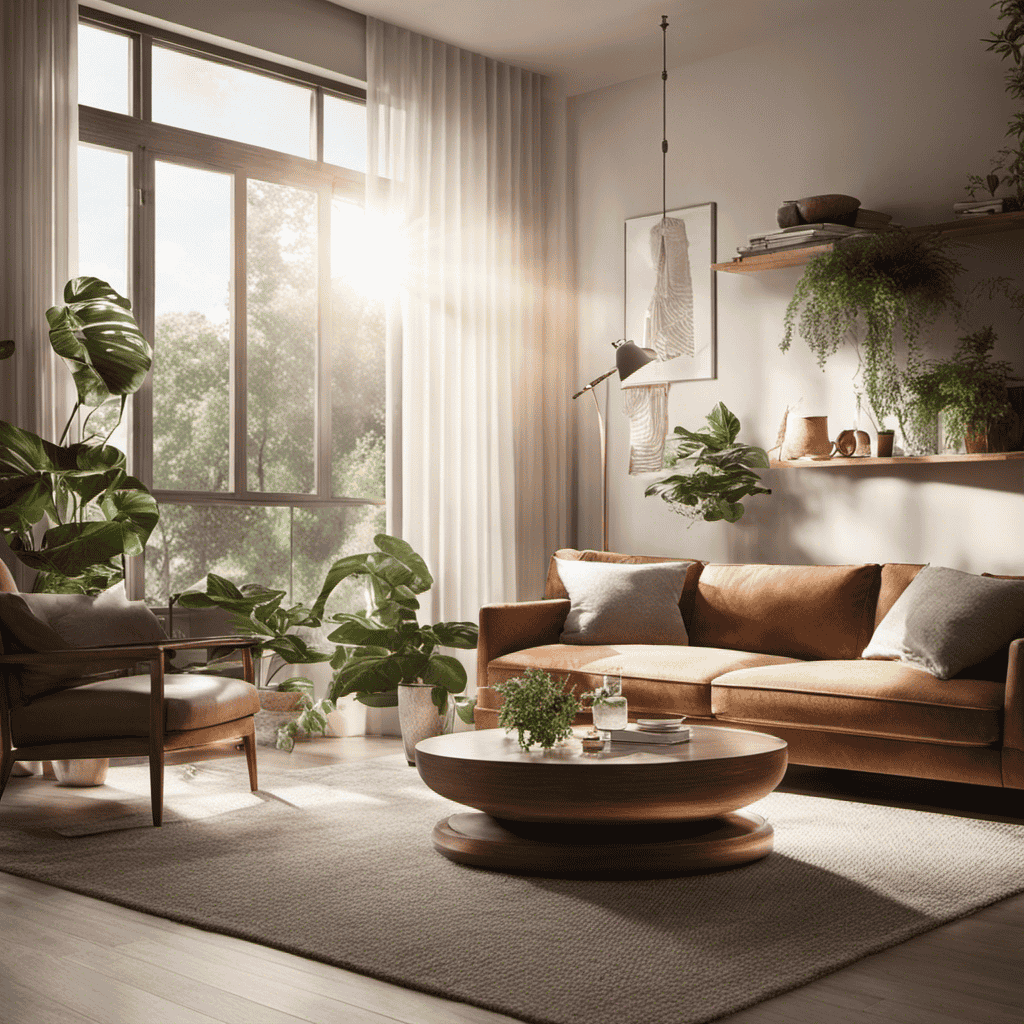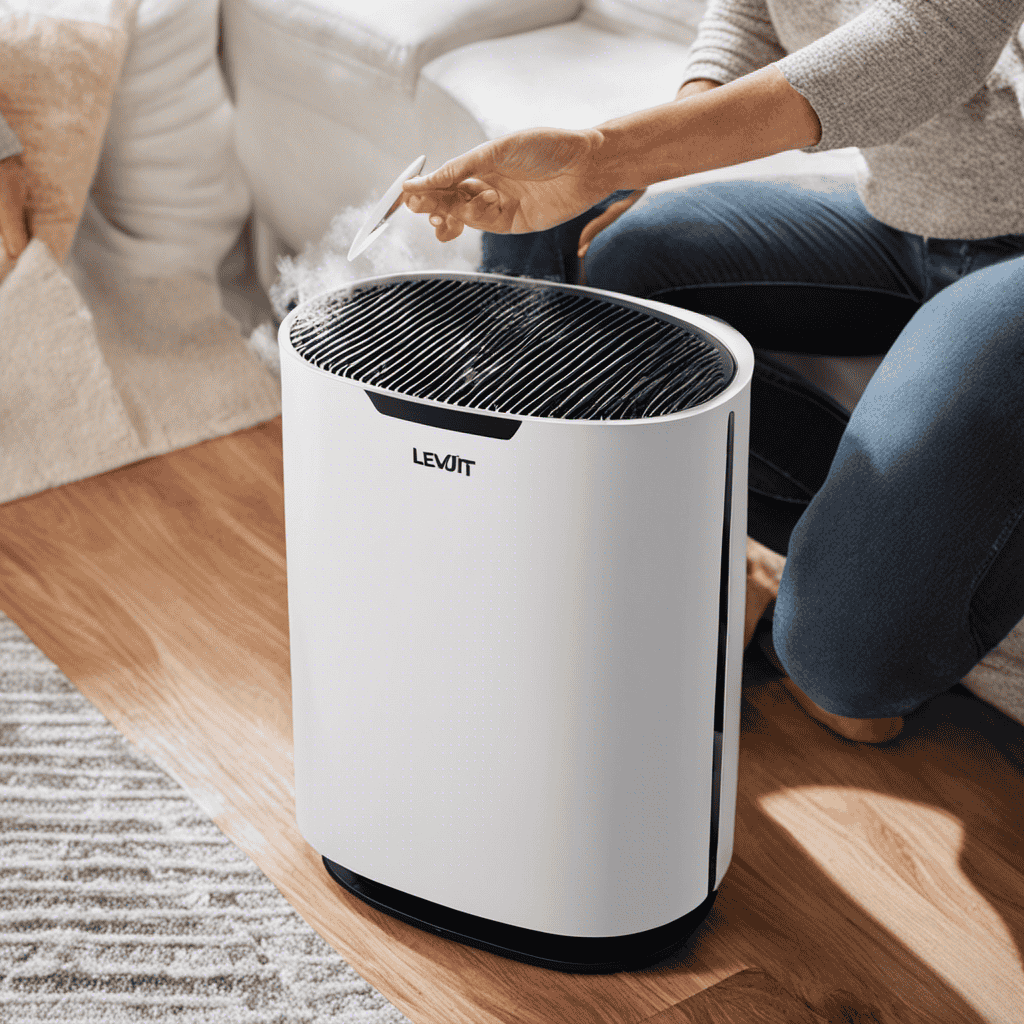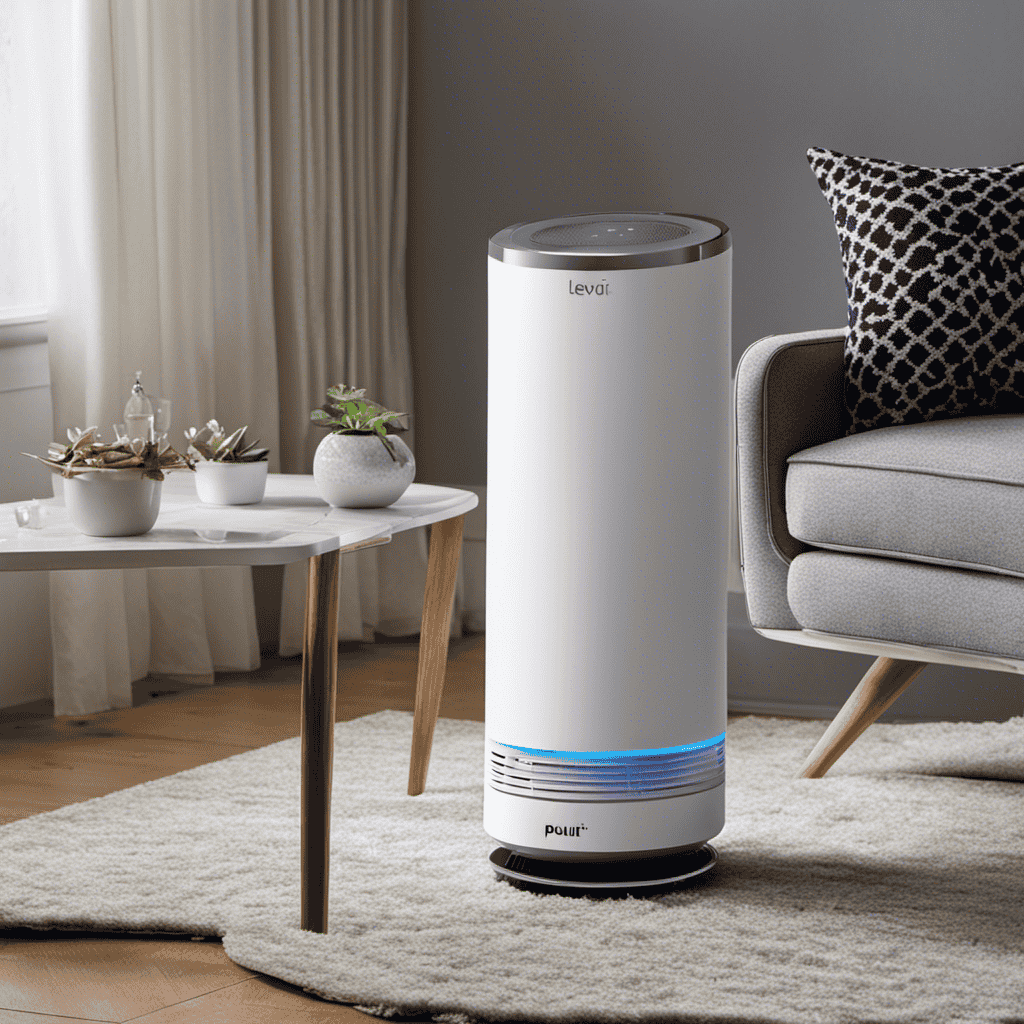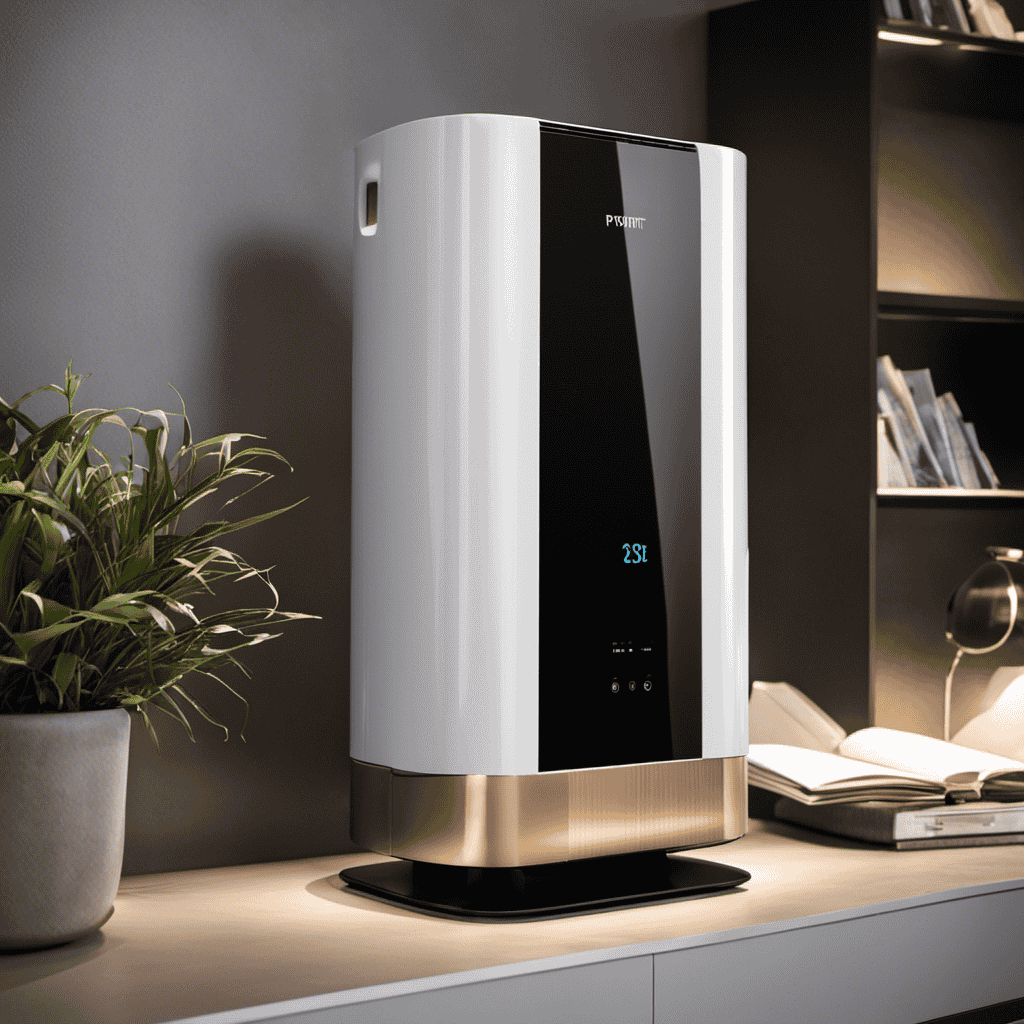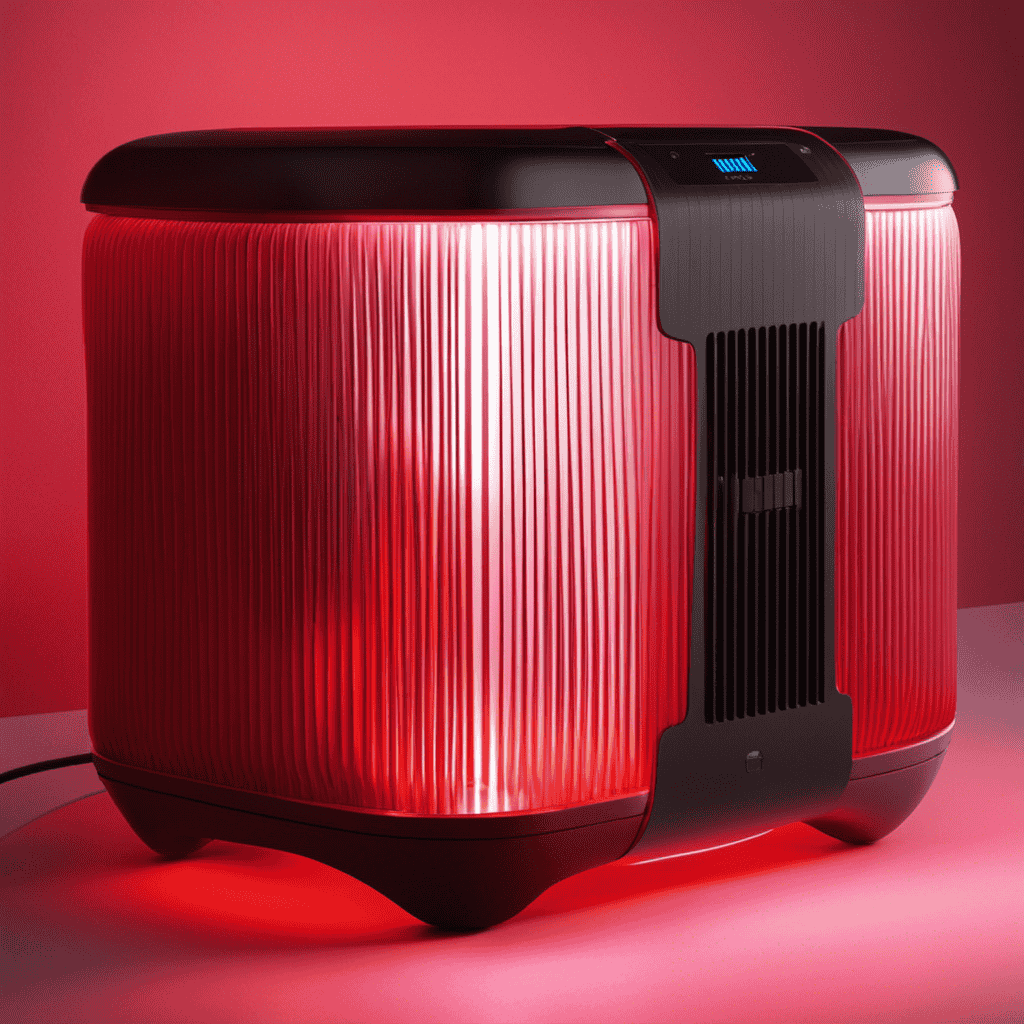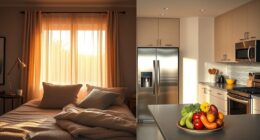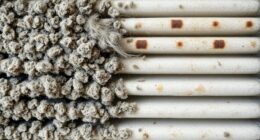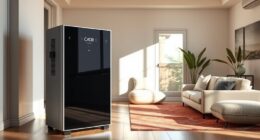By chance, have you ever thought about how long you should run your air purifier? This is a common question that many people have, especially when striving to maintain a clean and healthy indoor space.
In this article, I will delve into the recommended duration for operating an air purifier, considering factors like air quality, noise levels, and sleep quality.
By the end, you’ll have a better understanding of how to determine the ideal operating time for your air purifier, ensuring maximum effectiveness and efficiency.
So let’s get started!
Key Takeaways
- The duration for which an air purifier should be on depends on factors such as room size, air pollution level, sensitivity of individuals, time of day, and manufacturer’s recommendations.
- Regular monitoring and adjusting of usage time is necessary based on room size, air quality, occupancy, seasonal changes, and manufacturer’s guidelines.
- Maximizing air purifier effectiveness involves regular cleaning or replacement of filters, proper placement for optimal air circulation, troubleshooting common issues, regular maintenance, and following manufacturer’s instructions.
- The recommended duration for running an air purifier varies with each season, with longer periods suggested for spring (to remove allergens), summer (to combat outdoor pollutants), fall (to eliminate mold spores), and winter (to reduce indoor pollutants).
The Recommended Duration for Operating an Air Purifier
You should keep your air purifier on for at least 6 to 8 hours a day.
The duration of operating an air purifier can vary depending on several factors that affect the air quality in your environment.
Firstly, consider the size of the room or area where the air purifier is being used. Larger rooms may require longer operating hours to effectively clean the air.
Additionally, the level of air pollution in your surroundings can impact the duration. If you live in an area with high pollution levels, you may need to keep the air purifier on for longer periods to maintain clean air.
Ultimately, the goal is to ensure that you are breathing in clean and purified air, which can have a positive impact on your health.
Factors to Consider in Determining How Long to Use an Air Purifier
When determining how to use an air purifier, it’s important to consider various factors that can maximize its effectiveness.
One factor to consider is adjusting the usage time based on your activities. For example, if you spend most of your day at home, it would be beneficial to have the air purifier running continuously to ensure constant purification of the air. However, if you are only at home for a few hours a day, you can adjust the usage time accordingly.
Additionally, if you engage in activities that generate a lot of pollutants, such as cooking or smoking, it would be wise to keep the air purifier on during and after these activities to eliminate any lingering pollutants.
Understanding the air quality in your area and its impact on usage time is also crucial, as it can help you determine how long the air purifier needs to be on to maintain clean and healthy air.
Understanding the Air Quality in Your Area and Its Impact on Usage Time
Understanding the air quality in your area can help determine how frequently to use an air purifier. The air quality index (AQI) is a widely used measurement that indicates the level of pollutants in the air. Here are some important points to consider:
- High AQI levels indicate poor air quality, which can have detrimental effects on health.
- Pollutants such as PM2.5, ozone, and volatile organic compounds (VOCs) can lead to respiratory issues, allergies, and other health problems.
- Regularly monitoring the AQI can help you make informed decisions about when to use your air purifier.
- Factors such as weather conditions, nearby industrial activities, and seasonal changes can influence the air quality in your area.
How to Determine the Ideal Operating Time for Your Air Purifier
Determining the ideal operating time for an air purifier is crucial for maximizing its effectiveness. Factors such as room size, air quality, and the specific needs of individuals in the space can all influence how long the air purifier should be on.
To make an informed decision, it is important to consider these factors and gather evidence-based information to ensure optimal air purification.
Optimal Air Purifier Duration
The optimal duration for running an air purifier is typically based on the size of the room and the air quality. Factors affecting the duration include the level of pollutants in the air, the size of the space, and the sensitivity of the individuals occupying the room. Adjusting the usage time of the air purifier can help maintain clean and healthy air.
Here are some considerations:
-
Air quality: If the air quality is poor, it’s recommended to run the air purifier for longer periods of time to effectively remove pollutants.
-
Room size: Larger rooms may require a longer duration of operation to ensure proper air circulation and purification.
-
Sensitivity: Individuals with allergies or respiratory conditions may benefit from running the air purifier for extended periods to minimize symptoms.
-
Time of day: Running the air purifier during high-activity times, such as when cooking or cleaning, can help reduce the presence of airborne particles.
Factors Affecting Operating Time
To optimize the operating time of your air purifier, consider the factors that affect its effectiveness.
The ideal operating time and duration for air purifier usage can vary depending on several factors. First, consider the size of the room or space you are trying to purify. Larger rooms may require longer operating times to effectively clean the air.
Additionally, the level of air pollution in your environment will also impact the operating time. If you live in an area with high pollution levels, you may need to run the air purifier for longer periods to maintain clean air.
Lastly, consider the specific model of your air purifier and follow the manufacturer’s recommendations for optimal usage duration.
The Importance of Regularly Monitoring and Adjusting Usage Time
You should regularly monitor and adjust how long you keep the air purifier on to ensure its effectiveness. The monitoring frequency and adjusting strategies play a crucial role in optimizing the performance of your air purifier.
Here are some key points to consider:
- Room size: Larger rooms may require longer operating times compared to smaller spaces.
- Air quality: If you live in an area with high pollution or allergens, you may need to increase the usage time.
- Occupancy: The number of people in the room affects the amount of air pollutants generated, so adjust accordingly.
- Seasonal changes: Different seasons bring different airborne contaminants, so adapt the usage time accordingly.
Regular monitoring and adjustments based on these factors will help you maintain clean and healthy indoor air quality. By optimizing the usage time, you can ensure that your air purifier is working efficiently to remove pollutants and allergens from the air.
Tips for Maximizing the Effectiveness of Your Air Purifier’s Operation
By regularly monitoring and adjusting usage time, you can optimize the effectiveness of your air purifier’s operation. Maximizing performance is crucial for ensuring that your air purifier is effectively removing pollutants and improving indoor air quality.
To achieve this, it is important to follow a few tips. Firstly, make sure to clean or replace the filters regularly. Clogged filters can hinder the airflow and reduce the purifier’s efficiency.
Additionally, placing the purifier in the right location is essential. Keep it away from walls or furniture to allow proper air circulation.
Furthermore, troubleshooting common issues such as strange noises or weak airflow can also improve performance. Check for any blockages or obstructions in the air intake or outlet vents.
How Long Should You Run an Air Purifier in Different Seasons
When considering the optimal runtime of an air purifier, it is important to take into account the seasonal variations in air quality.
Different seasons bring different pollutants into the air, such as pollen in spring or smoke from wildfires in summer.
Optimal Purifier Runtimes
The optimal runtimes for air purifiers vary depending on the size of the room and the air quality. It is important to consider these factors when determining how long to run your air purifier to ensure maximum effectiveness.
Here are some general purifier runtime recommendations and the impact of purifier usage on air quality:
- Small rooms with good air quality: 2 to 4 hours per day
- Medium-sized rooms with moderate air quality: 6 to 8 hours per day
- Large rooms or rooms with poor air quality: 10 to 12 hours per day
For continuous air purification, consider running the purifier on low or medium settings.
Using an air purifier consistently can significantly improve air quality by removing allergens, pollutants, and odor-causing particles. However, it is essential to note that air purifiers are not a substitute for proper ventilation and regular cleaning.
Now, let’s explore the impact of seasonal air quality on air purifier usage.
Seasonal Air Quality
Seasonal changes can affect the quality of the air we breathe, making it important to adjust the runtime of our purifiers accordingly. As the seasons change, different pollutants and allergens may become more prevalent in the air. For example, during spring, pollen levels tend to increase, causing allergies to flare up. In the winter, indoor air quality can be compromised due to increased use of heating systems and less ventilation. To effectively maintain the air quality in our homes, it is essential to regularly clean and maintain our air purifiers. By doing so, we can ensure that the purifiers are functioning optimally and removing pollutants from the air. Additionally, using an air purifier consistently throughout the year can provide numerous benefits, including reducing asthma and allergy symptoms, eliminating odors, and improving overall respiratory health.
Here is a table highlighting the benefits of using an air purifier and the recommended maintenance tasks:
| Benefits of Using an Air Purifier | Air Purifier Maintenance |
|---|---|
| Reduces asthma and allergy symptoms | Replace air filters regularly |
| Eliminates odors | Clean the pre-filter |
| Improves respiratory health | Clean the fan and vents |
| Removes airborne bacteria and viruses | Check and clean the sensor |
| Filters out fine particles and pollutants | Monitor and adjust runtime |
Energy Efficiency Considerations
One way to conserve energy is by adjusting the runtime of our purifiers based on seasonal changes. By following energy-saving tips, we can not only reduce our impact on the environment but also save on our electricity bills. Consider the following:
- Use the air purifier only when needed, such as during times of high air pollution or when there are specific allergens present.
- Set the purifier on a timer to ensure it runs for a specific duration each day.
- Opt for energy-efficient models that have low power consumption.
- Clean or replace the filters regularly to maintain optimal performance and efficiency.
Adjusting the runtime of our purifiers can have a significant impact on our electricity bills while still ensuring clean air in our homes. However, another factor to consider is the influence of room size on the duration of air purifier usage.
The Influence of Room Size on the Duration of Air Purifier Usage
To determine how long an air purifier should be on, consider the influence of room size on usage duration. The size of the room plays a crucial role in determining how long an air purifier should be operating.
One factor that affects usage duration is the brand of the air purifier. Different brands have varying capabilities and efficiency in purifying the air, which can impact the time needed for effective purification.
Additionally, the placement of the air purifier within the room also affects its operating time. Placing the purifier strategically in an optimal location can maximize its efficiency and reduce the time required for purification.
Understanding the purification needs of different indoor spaces is essential for determining the appropriate duration for keeping the air purifier on.
Transitioning into the subsequent section, it is important to consider factors such as room occupancy, allergens present, and air quality goals to ensure effective air purification.
Understanding the Purification Needs of Different Indoor Spaces
When it comes to air purification, understanding the needs of different indoor spaces is crucial. Factors such as room size and air quality standards play a significant role in determining the effectiveness of air purifiers.
It is important to consider the size of the room when choosing an air purifier, as larger spaces may require more powerful units to adequately clean the air. Additionally, adhering to air quality standards can help guide the selection and usage of air purifiers, ensuring that they effectively remove harmful pollutants.
Room Size and Purification
If you have a larger room, you’ll need to keep the air purifier on for a longer period of time to ensure proper purification. The size of the room plays a crucial role in determining the effectiveness of air purification. Factors such as room layout and air circulation also come into play.
Here are some key considerations:
-
Room size: Larger rooms require more time for the air purifier to effectively circulate and clean the air.
-
Furniture placement: Objects like furniture can obstruct the airflow, reducing the purification effectiveness. Ensure that the purifier is placed in a central location with minimal obstructions.
-
Open space: If the room has an open layout, the air purifier can cover a larger area with better efficiency.
-
Air vents and windows: Proper air circulation is important for the purification process. Opening windows or ensuring that air vents are unobstructed can help improve the overall effectiveness of the air purifier.
Air Quality Standards
Maintaining healthy air quality is crucial for my well-being, and understanding the standards can help me ensure a safe environment.
Air pollution levels play a significant role in determining the quality of the air we breathe. High levels of pollutants such as particulate matter, volatile organic compounds, and nitrogen dioxide can have detrimental effects on our health. Exposure to these pollutants has been linked to various respiratory and cardiovascular diseases, including asthma, bronchitis, and even lung cancer.
Optimal Purifier Usage
To ensure you’re maximizing the benefits of your purifier, it’s important to use it in the most effective way possible. Here are some guidelines to help you optimize the performance of your air purifier:
-
Set the purifier to run continuously: While it may be tempting to turn it off when you leave the house, keeping it on all the time ensures continuous filtration and maintains clean air throughout.
-
Place the purifier in the right location: Position it in the room where you spend the most time, preferably near a source of air pollution like a window or doorway.
-
Clean or replace the filters regularly: Dirty filters can hinder the purifier’s effectiveness, so make sure to clean or replace them as recommended by the manufacturer.
-
Adjust the fan speed: Higher fan speeds can increase the purifier’s efficiency, but it may also create more noise. Find the right balance for your needs.
Is It Necessary to Run an Air Purifier Continuously
Running an air purifier continuously is necessary for maintaining clean indoor air quality. While there may be alternatives to continuous operation, such as using the air purifier only when you are at home or during specific times of the day, these options may not be as effective in achieving optimal air quality.
Studies have shown that air purifiers are most effective when they are running continuously, as this allows them to continuously filter out pollutants and allergens from the air. However, it is important to consider the impact of air purifier run time on electricity consumption.
Continuous operation may result in higher electricity usage, so it is important to find a balance between maintaining air quality and managing energy consumption.
The Impact of Air Purifier Usage on Energy Consumption and Cost
When considering the usage of air purifiers, it’s important to evaluate the impact on energy consumption and cost.
In order to make an informed decision, it’s necessary to compare the energy usage of different air purifier models and analyze their cost-effectiveness.
Energy Usage Comparison
You should compare the energy usage of different air purifiers before making a decision. When considering the energy-saving capabilities of air purifiers, it is crucial to take into account their impact on air quality.
Here are some factors to consider:
-
Energy efficiency: Look for air purifiers with ENERGY STAR certification as they are designed to consume less energy while still providing effective air filtration.
-
Filter type: HEPA filters are known for their high-efficiency in capturing airborne particles, but they may require more energy to operate due to their dense filtration material.
-
Fan speed settings: Air purifiers with adjustable fan speed settings allow you to customize the energy usage based on your needs. Lower fan speeds typically consume less energy.
-
Smart features: Some air purifiers have smart sensors that detect air quality and adjust their operation accordingly. These features can optimize energy usage while maintaining good air quality.
Cost-Effectiveness Analysis
To determine if an air purifier is cost-effective, consider factors such as initial price, operating costs, and maintenance expenses. When it comes to initial price, it is important to weigh the features and capabilities of the air purifier against its cost.
Additionally, operating costs should be taken into account, including energy consumption and the need for replacement filters. To maximize energy savings, opt for an air purifier with energy-saving features such as a timer or sleep mode.
Regular air purifier maintenance is crucial for optimal performance and longevity. This includes cleaning or replacing filters as recommended by the manufacturer.
By following these energy-saving tips and practicing proper air purifier maintenance, you can ensure that your investment is cost-effective in the long run.
Now, let’s explore how to balance air purifier usage with noise levels and sleep quality.
Balancing Air Purifier Usage With Noise Levels and Sleep Quality
Finding the right balance between using an air purifier and ensuring a good night’s sleep can be tricky due to noise levels. As someone who values both clean air and quality sleep, I have researched the impact of air purifier usage on sleep quality. Here are some key points to consider:
- Noise levels: Air purifiers can emit a certain level of noise, which may disrupt sleep for light sleepers.
- Placement: Positioning the air purifier away from the bed can help minimize noise disturbance.
- Noise settings: Some air purifiers offer different noise settings, allowing you to find a balance between clean air and a peaceful sleep environment.
- White noise benefits: For some individuals, the gentle hum of an air purifier can actually promote sleep by masking external noises.
To optimize sleep quality, it is important to find an air purifier with noise levels that are tolerable for you personally. Experimenting with different placements and noise settings can help strike the right balance between clean air and a restful night’s sleep.
The Role of Air Purifier Filters in Determining Usage Time
The role of air purifier filters in determining how often they need to be replaced can significantly impact the usage time of the device.
Air purifier maintenance, especially filter replacement, is crucial for the proper functioning and effectiveness of the unit.
Filters are responsible for capturing and removing pollutants, such as dust, pet dander, and pollen, from the air. Over time, these filters can become clogged and less efficient, reducing the purifier’s ability to clean the air effectively.
Most manufacturers recommend replacing filters every 3 to 6 months, depending on the level of air pollution and usage.
Regularly changing filters ensures optimal performance and prolongs the lifespan of the air purifier. Neglecting filter replacement can lead to decreased air quality and increased energy consumption.
Therefore, proper air purifier maintenance, including timely filter replacement, is essential for achieving clean and healthy indoor air.
How Often Should You Run an Air Purifier in High Pollen or Allergy Season
During high pollen or allergy season, it’s important to run your air purifier consistently to minimize the amount of allergens in the air. Understanding the frequency at which you should run your air purifier is key to reaping its benefits effectively.
Here are some key points to consider:
-
Consistency: Running the air purifier continuously ensures a constant filtration process, reducing the risk of allergens accumulating in the air.
-
24/7 Operation: Keeping your air purifier on all day and night provides ongoing protection against pollen and other airborne allergens.
-
Automatic Modes: Many air purifiers have automatic modes that adjust the fan speed based on the air quality, ensuring optimal filtration without manual intervention.
-
Personal Preferences: Depending on your sensitivity to allergens, you may choose to run the air purifier at a higher frequency to maintain a cleaner indoor environment.
Adjusting Air Purifier Usage Based on Household Occupancy and Activities
In order to maximize the efficiency of my air purifier, I have found that adjusting its usage schedule based on household occupancy and activities is crucial.
By being mindful of when and for how long the air purifier should be on, I can ensure that it is working effectively to remove pollutants from the air.
For example, if I know that my family is going to be out of the house for several hours, I can turn off the air purifier during that time to save energy and prolong the life of the device.
Additionally, if we are engaging in activities that generate more pollutants, such as cooking or cleaning, I can increase the usage time to ensure that the air is continuously being purified.
Frequently Asked Questions
How Often Should You Replace the Filters in Your Air Purifier?
I replace the filters in my air purifier every 3 to 6 months, depending on usage. Regularly cleaning the exterior of the purifier helps maintain its efficiency. Using an air purifier in the office can improve air quality and reduce allergens.
Can an Air Purifier Remove All Types of Pollutants From the Air?
An air purifier can effectively remove many types of pollutants from the air, including outdoor pollutants. This is beneficial for asthma sufferers, as it helps improve indoor air quality and reduces their symptoms.
Is It Safe to Leave an Air Purifier Running Overnight?
It’s necessary to run an air purifier all night for optimal air quality. Studies show that air purifiers can improve sleep quality by reducing allergens and pollutants in the air, promoting a healthier sleep environment.
Are There Any Health Risks Associated With Using an Air Purifier for an Extended Period of Time?
Extended use of an air purifier may increase noise levels and energy consumption. However, there are no significant health risks associated with prolonged operation. It’s important to consider individual needs and preferences when deciding how long to keep the air purifier on.
Can an Air Purifier Help With Pet Dander Allergies?
An air purifier can be effective for reducing pet dander allergies. When comparing air purifiers, look for ones specifically designed to remove pet dander. Keep it on for as long as needed to maintain clean air.
Conclusion
In conclusion, determining the optimal duration for operating your air purifier is no easy task. It requires a delicate balance of understanding your local air quality, monitoring usage time, and considering noise levels and sleep quality.
It’s like conducting a scientific experiment in your living room! But fear not, dear readers, for with proper adjustments and regular filter maintenance, you can create a pristine indoor environment that rivals the cleanest laboratories.
So go forth, my evidence-seeking comrades, and let your air purifier be your trusty sidekick in the quest for fresher air!
